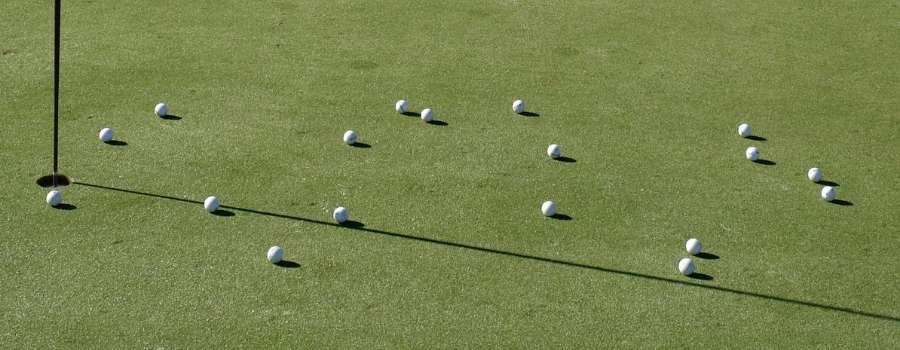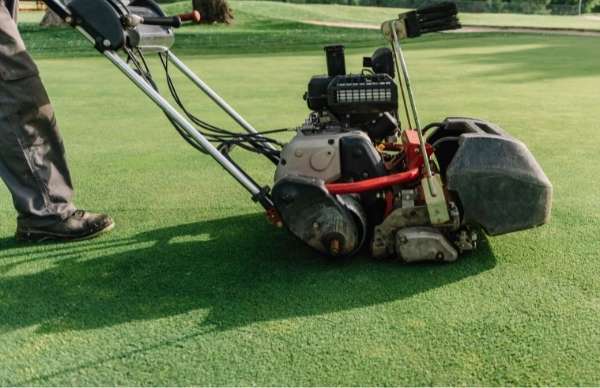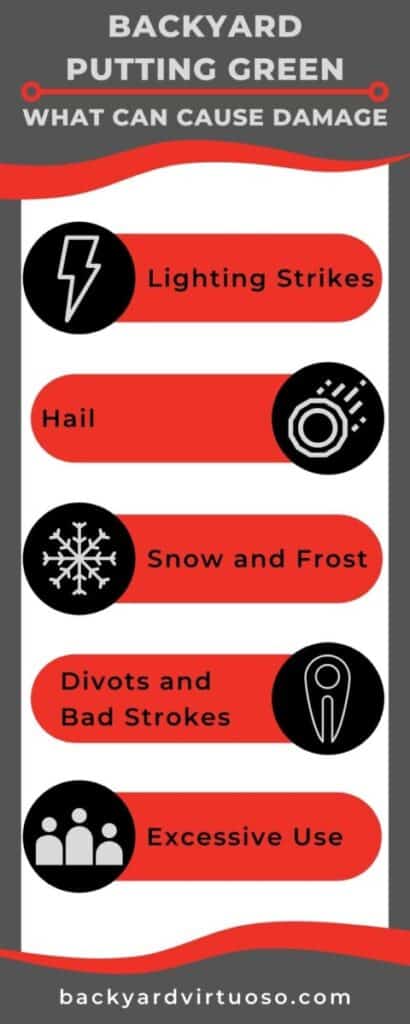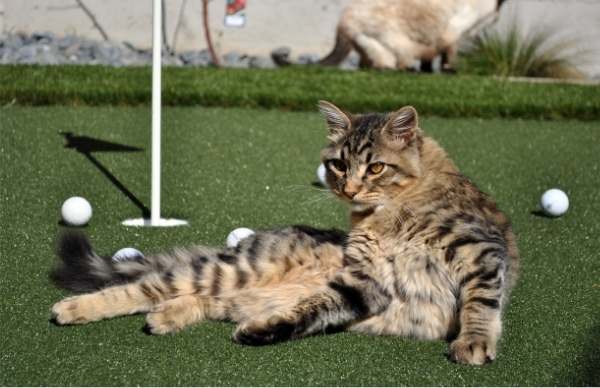
There are a lot of different factors that go into determining how long your backyard putting green will last and you’ve already invested…or are planning to…a large bit of money to have one installed at your home, so you’re going to want it to last as long as possible.
Your budget, the type of turf you choose, and even where you live can all have an impact on the life expectancy for your new green.
The good news is that there are a few things you can do to extend its lifespan and make it as durable as possible. I’ve gone to the experts to get the best advice and compiled it here for you!
How Long Will A Backyard Putting Green Last?
In general, a real grass backyard putting green should last a lifetime as long as regular maintenance is performed and no major natural or accidental disasters destroy it. Artificial turf can last for up to 15 years as long as it is also well maintained at least 2-3 times a year.
There are some differences in both the longevity and the price between natural grass putting greens and artificial putting green. I’ve broken that down in the subsections below, but for quick reference, I’ve put together this chart.
| Type of Surface (cost to Install) | Maintenance Cost (per year) | Longevity |
| Natural Grass (~$3000) | $9,000 – $12,000 | Lifetime (w/Proper Care) |
| Artificial (~$4500) | $500 – $700 for Patches | 15 Years |
Natural Grass
There is no reason that a natural grass putting green can’t last as long as you own your home. But, it’s not going to take care of itself…like anything you want to last, you have to make sure you are properly maintaining your greens. I go into more detail about this over in this article but in short, you will want to:
- Have proper irrigation
- Fertilize in the Spring and the Fall
- Remove Leaves and debris from the putting surface
- Have your sand traps professionally cleaned (especially if you have drainage underneath)
Of course, maintaining a natural grass putting green can be an expensive undertaking, especially for the DIY type of person.

In order to keep the putting surface grass short (the average grass length on a putting green is about .125″), you are going to need a riding mower or a push mower that can cut that short. One of these mowers can run about $500+.
As a side note, the professional says that while you can use a push mower a riding mower is recommended since push mowers are more prone to gouging, scuffing, or dragging the putting green surface.
In order to keep the grass this short, you’ll need to mow it often, most professional courses mow their greens at least once a day in the Spring and Summer. If you can’t swing that, I would suggest at a minimum mowing your green every other day in the summer months.
Professional maintenance costs about $50-75 per visit for this type of work…so it’s going to add up quickly, BUT…you won’t have to get out there and do it yourself.
One recommendation some professional lawn care people told me is to split the difference, meaning have a professional come out and mow it down to proper length once a month and mow it yourself with a standard push mower daily or every other day the rest of the month.
You may not get the grass as short as the suggested .125″, but you should get it fairly close.
You will also need a good fertilizer to keep your grass green and healthy. You can go with organic or synthetic, but make sure you stay away from anything that has weed killer in it as this is not good for the putting surface itself. Luckily, fertilizing is fairly easy, not a huge time sink, and isn’t all that expensive coming in at around $20 for enough to last you the entire year.
Artificial Turf
Since artificial turf is made of synthetic materials, they are going to eventually break down. That being said, a good quality artificial turf putting green that is well maintained should last you up to 15 years.
Natural disasters can, of course, destroy your green the day after you put it in but there are always ways to mitigate that kind of damage as long as you know it’s coming.
The upside to artificial turf is that it is always going to stay the same length…no mowing, trimming, or worry about brown spots.
You also don’t need to worry about fertilizing artificial turf…so that’s one chore/expense you don’t have to plan for.
The biggest downside is that as the artificial grass fibers break down, you may end up with “rubbed” or warn-out spots. These spots can create smooth spots or divots on your putting surface.
If you were to accidentally gouge a chunk of grass from your real grass green, you can always reapply it, smooth it out, and it should repair itself in a few days to a week.
With artificial turf, you either have to replace the entire green or have a professional come in a cutaway the bad spot and patch in a new piece of turf. This can cost a good bit of money (around $500-700), and there is a small chance that the patch won’t sit, feel, or look quite right.
What Can Damage A Backyard Putting Green?
Natural disasters are going to do the most damage to a putting green but bad strokes, excessive people, animals, divots, and amount of use are all factors that can deplete the longevity of your putting green.
Here’s a quick list of things that could potentially damage and shorten the life of your putting surface, and then I’ll unpack a few below:

- Lighting Strikes
- Hail
- Snow and Frost
- Divots
- Bad Strokes
- Animals
- Excessive Use
Lightning Strikes
Lighting strikes actually burn thin holes in your putting surface which will be noticeable if you aren’t lucky enough for them to self-repair.
If they don’t, chances are it’s time to call a professional out and get some new turf put in.
Hail
Small-sized hail probably won’t be hard enough or have enough downward force to do any damage to your putting green surface.
The grass and layer of dirt just under the surface are likely enough to cushion any blows.
Large hail will definitely do some damage, and if the ground is already wet from rain or a recent watering, you might find chunks of turf being ripped up by the ice pellets.
This can look pretty bad but usually self-repairs fairly well if it’s not too severe.
Snow and Frost
If your putting green gets covered in snow, it’s definitely going to take a beating. Ice can form underneath the snow and cause divots, uneven surfaces, and soft spots which will then need to be repaired by cutting out that section of turf.
If your green is covered in frost or ice for more than 48 hours straight then you may want to cover your green with a tarp.
This will help channel away moisture as the snow melts and will also create a self-contained eco-system under the tarp which will help keep your grass warm and moist.
When you pull the tarp off in the spring then your grass should be lush and green, ready to mow, and get back to practicing.
Divots
If someone takes a bad swing, catches the side of your green, or hits off into the woods, it’s going to leave a divot on your putting surface. These can be repaired by simply replacing that section with new turf (or patching if it’s been cut out).
If you’re practicing a lot of lob shots then the repeated impact of the ball dropping onto the putting surface will also cause divots. The best practice here is to use a divot tool…or golf tee in a pinch…to pull the divots back out after every few shots.
Bad Strokes
Too much use will definitely take a toll on your putting green and over time you might start to see the fibers in your turf become visible, or parts of it may start to curl up or down. If this happens, then chances are it’s just about ready for some new grass!
Animals
If you have a pet, they will probably love to roll around on your green…and this is going to do some damage for sure. They may also cause divots or eat the grass blades if allowed access.
Animals will likely need to be trained/kept off of it as much as possible and those divots will either need filled in or replaced depending on how bad they are.
This is another area artificial turf may help. While not guaranteed to keep pets off, animals shouldn’t be as tempted to dig and rummage around on artificial turn as they would be on natural grass.

Excessive Use
If your green is being used a lot, this will definitely show in the turf fibers and it might start to curl up over time towards one side or another…which isn’t good for putting! If you have a large family or friends over often, this can also lead to too much use.
If you plan to use your green often or plan to have gatherings of people coming over to use it then you might want to ask a professional for ways to make the surface more durable…like possibly going with an artificial turf rather than natural grass, or adding a thicker layer of foundation under the surface.
Final Thoughts
Growing up in Alaska I always dreamed of having two things in my backyard when I finally moved to a warmer climate…a pool and a putting green, two things that don’t make much sense to have in Anchorage, Alaska but things that make perfect sense…and really are almost expected in southern states like Dallas, Texas.
Of course, we adults know that you have to use some judgment when making such purchases…and one of those decisions is if your investment is going to stand the test of time.
Weighing things like maintenance cost, replacement cost, the amount of space it takes up in your backyard vs. what you’re current families needs are extremely important so hopefully, this article has given you a little food for thought.
